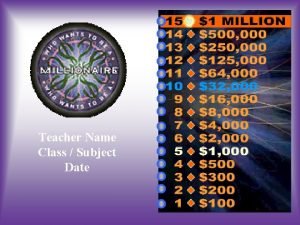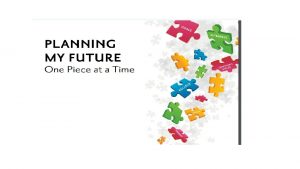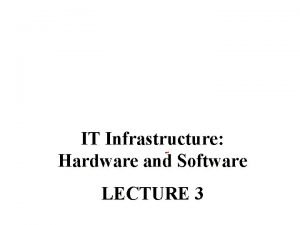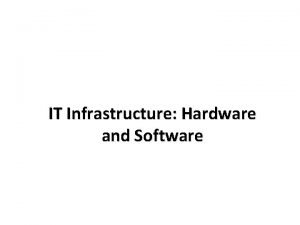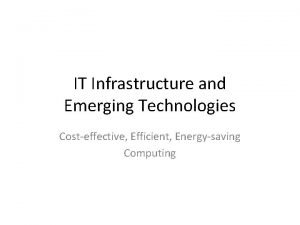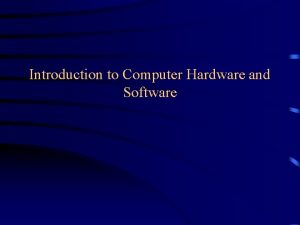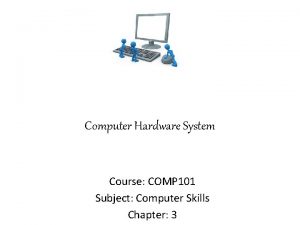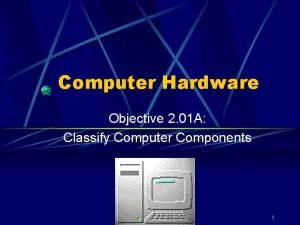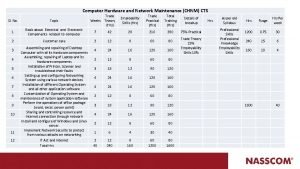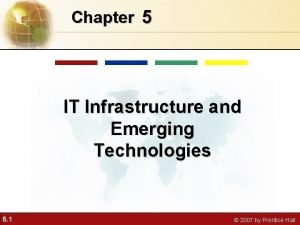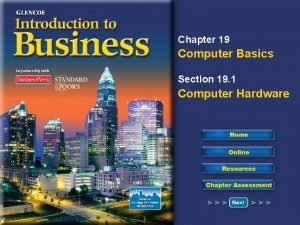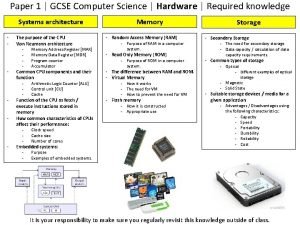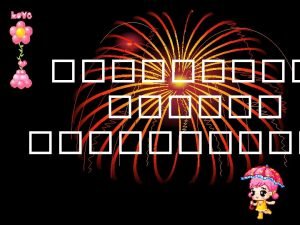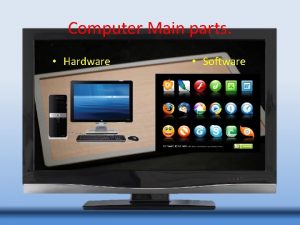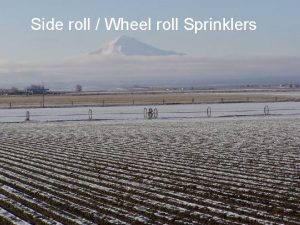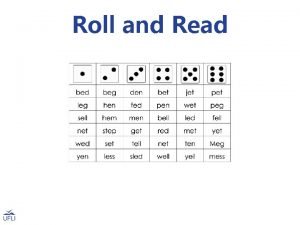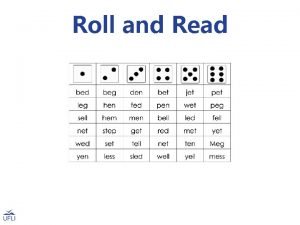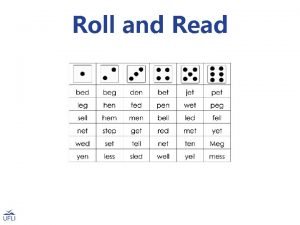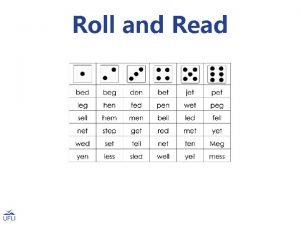COMPUTER HARDWARE NAME CLASS ROLL NO Computer Hardware



















- Slides: 19

COMPUTER HARDWARE NAME: CLASS: ROLL NO:

Computer Hardware Overview The Basics Parts of the computer • Motherboard • Microprocessor • Computer Memory (RAM) • Hard Disk Drive • CD Drives • Floppy Drive • Video Card • Monitor • Modem • Network Devices Additional Accessories • Printers • Scanner • UPS • Speaker

Motherboard The mother for : - Microprocessor Chips - Memory Chips - For the other internal components that enable your system to function Can be detrimental to: - Overall Microprocessor speed - Scalability

Microprocessors: The Main Engine The Microprocessor Buried somewhere on that big motherboard is a specific chip that controls your entire computer system. This chip is called a microprocessor or a central processing unit (CPU). The Microprocessor is responsible for: - processes all the instructions necessary for your computer to perform its duties - running the computer system with speed and efficiency - CPU speed is measured in megahertz (MHz) - Today's fastest chips are actually measured in gigahertz (GHz) How fast is 1 Gigahertz? 1000 MHZ, or one billion cycles per second!

Computer Memory: (RAM) Before your CPU can process any instructions you give it, those instructions must be stored somewhere, in preparation for access by the microprocessor - The more memory that is available in a machine, the more instructions and data that can be stored at one time. - If the computer does not have enough RAM to run an application than pieces of the running application will be stored on the Hard Drive temporarily in a method known as “Virtual Memory” and the CPU will then have to retrieve information from the virtual memory causing a bottleneck in the system. RAM Types: SIMM - Short for single in-line memory module, SIMM has 32 -bit path. You must install SIMMs two at a time to stay consistent with 64 bits. DIMM - Short for dual in-line memory module, DIMM has 64 -bit path. The Pentium processor requires a 64 -bit path to memory thus you can install DIMMs one or two at a time if you wish. DDR RAM - Short for Double Data Rate-RAM, a type of RAM that supports data transfers on both edges of each clock cycle (the rising and falling edges), effectively doubling the memory chip's data throughput. DDR-RAM also consumes less power. • 32 MB / 64 MB / 128 MB / 256 MB / 512 MB RAM is measured in bytes: • 1 GB / 2 GB / 4 GB / 8 GB etc.

Hard Disk Drives: Long-Term Storage The hard disk permanently stores all your important data. Some hard disks can store more than 100 gigabytes of data. ATA – Advanced Technology Attachment Serial ATA (SATA)- an evolution of the Parallel ATA physical storage interface. Transfer rates for Serial ATA begin at 150 MBps.

CD/DVD Drives Information on a CD/DVDROM is encoded in the form of microscopic pits (representing the 1 s and 0 s of computer binary language) below the disc's surface. Capacity of CDs are usually comes with 700 MB. Capacity of DVDs are usually comes with 4. 7 GB.

Monitors Operating a computer would be difficult if you didn't constantly receive visual feedback showing you what your machine is doing. This vital function is provided by your computer's monitor. Additional Terms: CRT – Cathode Ray Tube, the technology used in most televisions. LCD – Liquid Crystal Display, a type of display used in digital watches and many portable computers Monitor’s resolution measured in pixels. Some SVGA Resolutions are: 800 x 600 1024 x 768 1600 x 900 etc.

Video Cards A board that plugs into a personal computer AGP Port on the motherboard to give it display capabilities. - Modern video adapters contain memory, so that the computer's RAM is not used for storing displays. - Modern adapters have their own graphics coprocessor for performing graphics calculations. These adapters are often called graphics accelerators. VGA Video adapters inbuilt in Motherboard VGA or AGP Video card for High Resolution.

Modems: Getting Connected Almost all PC systems today include a modem. A modem enables your computer to connect to a telephone or cable line and transmit data to and from the Internet. - Modems come in either internal (card-based) or external models that hook up to an open port on the back of your system. The following characteristics distinguish one modem from another: bps - How fast the modem can transmit and receive data. The fastest modems run at 57, 600 bps. voice/data - Many modems support a switch to change between voice and data modes. In data mode, the modem acts like a regular modem. In voice mode, the modem acts like a regular telephone. data compression - Some modems perform data compression, which enables them to send data at faster rates. Fax capability - Most modern modems are fax modems, which means that they can send and receive faxes

Networking • Connectivity of two or more computers is called Networking. There are 3 types of Networking. • LAN- Local Area Network • MAN- Metropolitan Area Network • WAN- Wide Area Network

Network Interface Devicesfor Networking The most common type of network is a wired network using Ethernet cables and hardware. For this type of network, you need to install and configure a Network Interface Card (NIC) in each of your PCs. Types of Networking Topologies LAN Card UTP or LAN Cable & RJ 45 connector

Printers 3 Selling Points: * All in one features (i. e. scanning, copying, printing, faxing) * Standalone capabilities * Resolution - Refers to the sharpness and clarity of an image. 300 dpi (dots per inch) For example, a 300 -dpi (dots per inch) printer is one that is capable of printing 300 distinct dots in a line 1 inch long. This means it can print 90, 000 dots per square inch. Screen Resolution - the screen resolution signifies the number of dots (pixels) on the entire screen. For example, a 640 -by-480 pixel screen is capable of displaying 640 distinct dots on each of 480 lines, or about 300, 000 pixels. PPM (Page Per Minute) - Stands for pages per minute and is used to measure the speed of certain types of printers Also take note that typically this measurement is for Text and NOT graphics.

UPS Uninterruptible Power Supply, a power supply that includes a battery to maintain power in the event of a power outage. Typically, a UPS keeps a computer running for several minutes after a power outage, enabling you to save data that is in RAM and shut down the computer gracefully There are two basic types of UPS: - standby power systems (SPSs) - SPS monitors the power line and switches to battery power as soon as it detects a problem. - on-line UPS systems – provides constant power from its own converter.

Software • A computer needs both Hardware and Software for its functioning. By software we means Computer instruction and data. Anything that can be stored electronically is software. The storage devices and input/ output devices are hardware.

Types of Software • Software is often divided into two catagories. • System Software Includes the Operating system and all the utilities that enable the computer to function. Example- DOS, Windows’ 95, Windows 8, Macintosh, OS/2 etc. • Application Software Includes programs that do real work for users. For example. MS Word, MS Excel, Photoshop, Tally etc.

Operating System • An operating system is the most important software that runs on a computer. It manages the computer's memory, processes, and all of its software and hardware. It also allows you to communicate with the computer without knowing how to speak the computer's "language. " Without an operating system, a computer is useless.

Virus • • What is a computer virus? Computer viruses are small software programs that are designed to spread from one computer to another and to interfere with computer operation. What do computer viruses do? Through the course of using the Internet and your computer, you may have come in to contact with computer viruses. Many computer viruses are stopped before they can start, but there is still an ever growing concern as to what do computer viruses do and the list of common computer virus symptoms. A computer virus might corrupt or delete data on your computer, use your email program to spread itself to other computers, or even erase everything on your hard disk. Computer viruses are often spread by attachments in email messages or instant messaging messages. That is why it is essential that you never open email attachments unless you know who it's from and you are expecting it. Viruses can be disguised as attachments of funny images, greeting cards, or audio and video files. Computer viruses also spread through downloads on the Internet. They can be hidden in illicit software or other files or programs you might download.

Antivirus • What is antivirus software? • Antivirus software is a computer program that detects, prevents, and takes action to disarm or remove malicious software programs, such as viruses and worms. You can help protect your computer against viruses by using antivirus software, such as Microsoft Security Essentials, Norton, Kaspersky, Quick Heal etc.
 Seminole wind by john anderson
Seminole wind by john anderson Class maths student student1 class student string name
Class maths student student1 class student string name Private string name java
Private string name java Name date class
Name date class Subject teacher name
Subject teacher name Name date class teacher
Name date class teacher Name
Name External and internal hardware
External and internal hardware Define interrupts in microprocessor
Define interrupts in microprocessor Language tool
Language tool Software and its types
Software and its types Computer hardware platforms in it infrastructure
Computer hardware platforms in it infrastructure Introduction to hardware and software
Introduction to hardware and software Computer arithmetic: algorithms and hardware designs
Computer arithmetic: algorithms and hardware designs Computer hardware 101
Computer hardware 101 Computer hardware classification
Computer hardware classification Computer hardware and network maintenance
Computer hardware and network maintenance It infrastructure and emerging technologies
It infrastructure and emerging technologies Graphic organizer of computer hardware
Graphic organizer of computer hardware Hardware gcse computer science
Hardware gcse computer science




